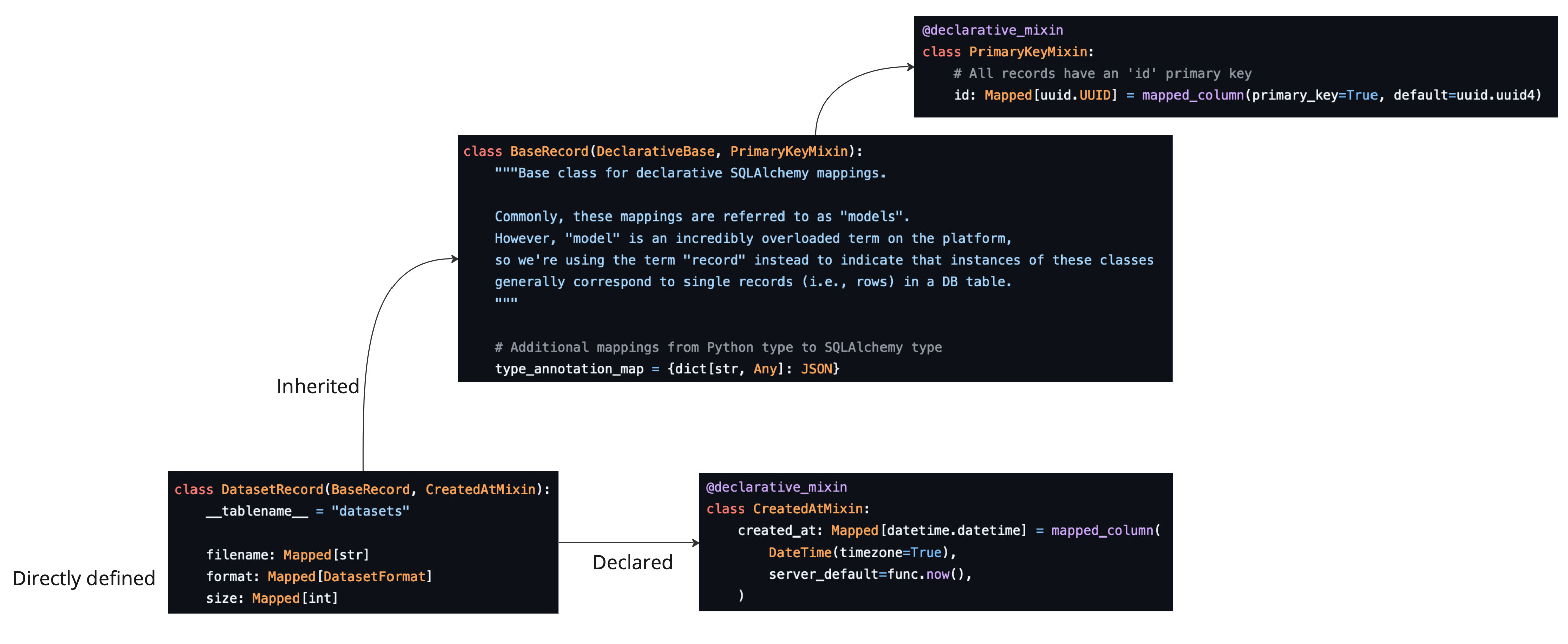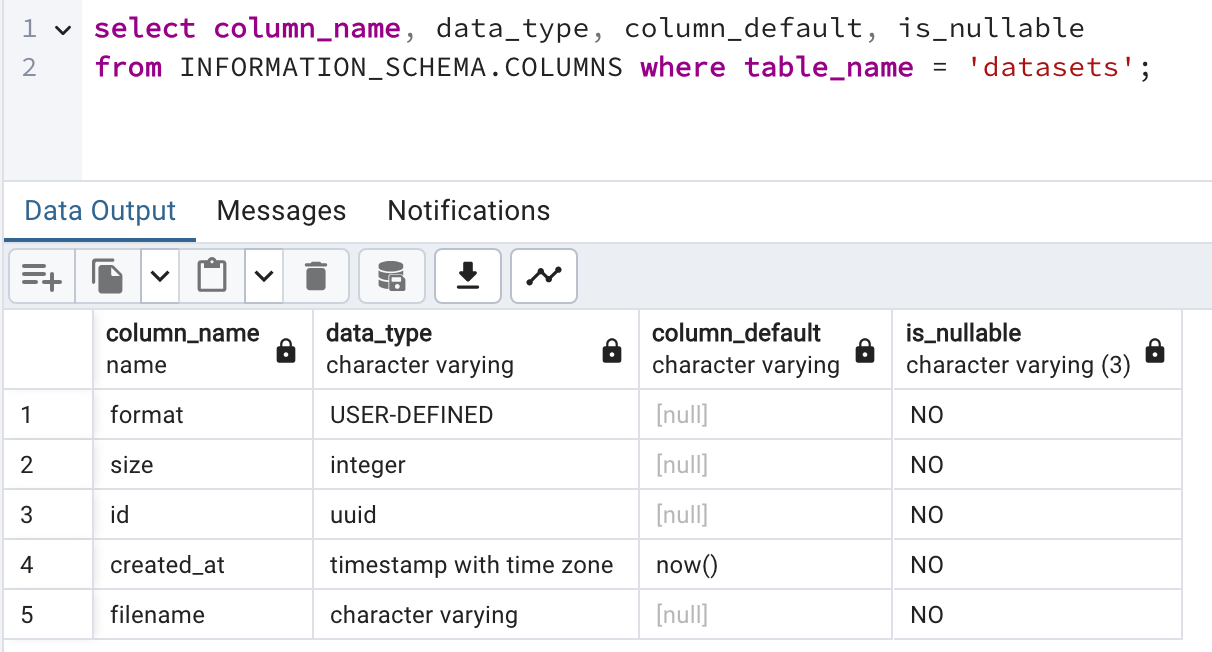Understanding Lumigator Endpoints
This document shows how current endpoints in lumigator work. If you want to customize lumigator with your own custom endpoints/jobs this is a good place to start!
Lumigator’s architecture
The diagram below shows the current architecture of Lumigator. The larger containers (Backend, Ray cluster, SQL database, and S3-compatible Storage) are the different services Lumigator relies on:
The components inside the backend, shown in the image below, are the different abstraction layers the backend itself relies on:
The API makes backend functionalities available to the UI through different routes (see: schema code ). Schemas are used in the API which allows one to exactly know which kind of data has to be passed to it.
Services implement the actual functionalities and are called by the different methods exposed in the API (see: backend services ).
Repositories implement the repository pattern as an abstraction over the SQL database (see: code for repositories ). They make use of record classes to refer to actual records in the database.
Notation
In the following, we will refer to paths inside Lumigator’s repo relative to the
/lumigator/backend folder, e.g. the relative path backend/api/routes (note the lack of a
trailing slash) will map to the absolute path from the root of the repo
/lumigator/backend/backend/api/routes.
Lumigator endpoints
All the endpoints you can access in Lumigator’s API are defined in
backend/api/routes/
and explicitly listed in
backend/api/router.py,
together with a metadata tag
which is used to provide a short description of the route.
Let us now walk through a few examples to understand how Lumigator’s endpoints work.
The simplest endpoint: /health
The /health
route provides perhaps the simplest example as it allows you to get the current backend status which
is a constant:
@router.get("/")
def get_health() -> HealthResponse:
return HealthResponse(deployment_type=settings.DEPLOYMENT_TYPE, status="OK")
Note that the returned type is a HealthResponse: this is a
pydantic model defining the schema of the
returned data. The general rule is that all return values in our routes should match a predefined
schema. Schemas are defined under the schemas directory (see: health response in our source code),
typically in files with the same name of the route, service, etc.
All the code for get_health() appears in the route file. A HealthResponse, composed of a
deployment type which is loaded from
backend/settings.py
and the status (currently always ok), is returned.
One step further: /datasets
The /datasets route is a bit more complex as it has to interface both with the DB and the storage.
The simplest method there, get_dataset, already has basically all the components you’d find in
most of the advanced methods:
@router.get("/{dataset_id}")
def get_dataset(service: DatasetServiceDep, dataset_id: UUID) -> DatasetResponse:
return service.get_dataset(dataset_id)
The core functionalities are provided by a service (in this case a
DatasetService) defined inbackend/services/datasets.py.Instead of directly passing a
DatasetServiceto theget_datasetmethod, DatasetServiceDep is defined to perform a dependency injection (see: FastAPI’s dependencies).As with the
/healthendpoint, a schema defines the return type (in this case aDatasetResponse).The
repositoryabstraction is used to access data in the database.
So, let us suppose you have already uploaded a dataset to Lumigator. What happens when you hit the
/datasets endpoint by passing a dataset id?
First thing, DatasetServiceDep will make sure that all the dependencies to run your
DatasetService are met. If you look at
backend/api/deps.py
you will see that a DatasetServiceDep is nothing more than a DatasetService that depends on a
DBSessionDep and S3ClientDep:
def get_dataset_service(
session: DBSessionDep, s3_client: S3ClientDep, s3_filesystem: S3FileSystemDep
) -> DatasetService:
dataset_repo = DatasetRepository(session)
return DatasetService(dataset_repo, s3_client, s3_filesystem)
DatasetServiceDep = Annotated[DatasetService, Depends(get_dataset_service)]
DBSessionDep and S3ClientDep provide an additional level of dependencies, namely on a
database session and on an S3 client.
While the S3 dependency is a “simple” one (i.e., it just instantiates a boto3 client in place), the
database one is a bit more advanced (i.e., it relies on a
DatabaseSessionManager
to return a session).
Second, DatasetService provides a get_dataset method which gets the actual data from the
database and returns a DatasetResponse after validating it:
def get_dataset(self, dataset_id: UUID) -> DatasetResponse:
record = self._get_dataset_record(dataset_id)
return DatasetResponse.model_validate(record)
def _get_dataset_record(self, dataset_id: UUID) -> DatasetRecord:
record = self.dataset_repo.get(dataset_id)
if record is None:
self._raise_not_found(dataset_id)
return record
We access the database using the repository abstraction DatasetRepository class. All
repositories are defined in backend/repositories and inherit from
BaseRepository
which is a general class providing ORM access to SQL statements. In particular, the
DatasetRepository is a BaseRepository working with items of type
DatasetRecord.
Fields in records are defined as a mix of explicit type definitions and declarative mappings (see the picture below to see how the fields in the datasets table are defined).

Definition of the fields appearing in DatasetRecord:

Common patterns
The examples above show the main patterns we follow to develop a generic endpoint. These are reflected in a rather standard code structure:
Directory |
Description |
|---|---|
backend/api/routes |
The actual API endpoints one can hit. |
backend/services |
The code that implements core functionalities for each route. |
backend/api/deps.py |
Used to inject dependencies for services. |
backend/repositories |
Repositories used by each service. |
backend/records |
Records used by each service. |
schemas |
The schemas used by each route/service. |
The general rule is that for most endpoints you’ll end up with an identical filename for each of the
above directories (see e.g. datasets, experiments, etc).
Next steps
Now that you have a basic understanding of how Lumigator’s endpoints work, you can start creating your own! The best way to do this is to start by copying an existing endpoint and modifying it to fit your needs.